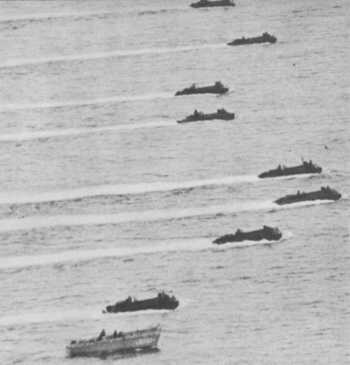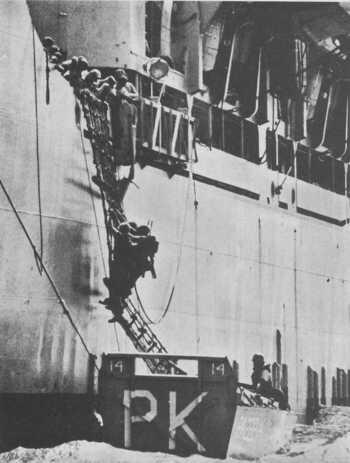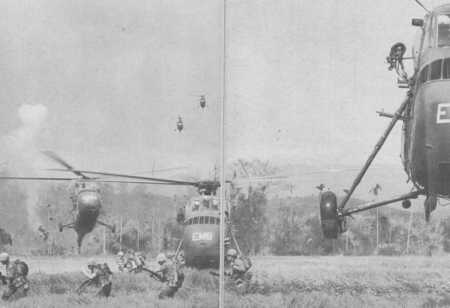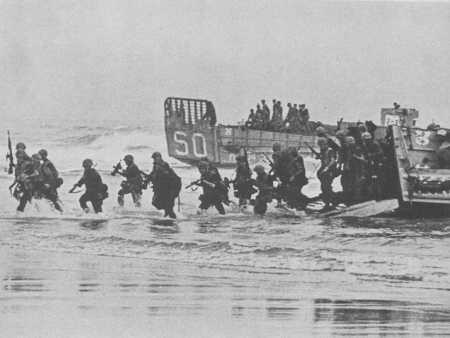
This is a direct reproduction of the original content of ALL HANDS magazine.
©All Hands Magazine, Inc. All rights reserved. Reproduction by permission
only.
Navigate through the "pages" by clicking on the page numbers, next or back links at the bottom of your screen or by clicking the links in the Table of Contents.
Landing Force - Then and Now
ANYONE who watches the late show on television regularly is probably impressed by the sheer numbers of those WW II blood-and-thunder movies of amphibious landings on Iwo Jima, Guadalcanal, and elsewhere. But even if you have been seeing too many of them lately you gotta admit they were EXCITING.
Twenty-five years after World War II, we're still making amphibious landings in the Pacific. Nowadays, however, they may not be so exciting -in fact, because of the nature of the current conflict, they may be more aptly described as exacting -and tedious.
However unglamourous today's landings in Vietnam may be, one factor remains the same-they're still involved maneuvers, requiring lots of advance planning, expert timing, and cooperation between Navy and Marine forces.

HEADING IN - First wave of amphibious craft heads ashore during amphibious attack in Vietnam. Below: Marines debark from attack transport USS Pickaway.

The pattern for the World War II landings is pretty familiar-
First, the heavy bombardment by the big guns of the Fleet, joined by the aircraft embarked in its carriers, giving the enemy troops dug in on the island a good working over.
Then the frogmen launched from their little rubber rafts carrying sacks of high explosives to the beach. Their job was to blow up the man-made obstacles strung along the coast to clear the way for the waves of landing boats.
Hundreds of assault craft maneuvered into position alongside the
troop ships to take aboard their load of Marines. Like a medieval phalanx the
boats lined up waiting for the order to charge toward the beach and the waiting
enemy gunfire.
The order finally came to land the landing forces, and the boats thrust ahead . . . and you know the rest.


AFTER WORLD WAR II, the amphibious forces trained, practiced,
and prepared themselves to meet similar military situations, and the techniques
used in 1943 were pretty much the same in 1950, when two divisions of troops
poured into Korea in the brilliant landing operation at Inchon.
Amphibious warfare is defined by an official publication on the subject as "The
conduct of military operations in which sizable forces are transferred from sea
to a hostile, or potentially hostile, shore, for the purpose of initiating
sustained land actions."
U. S. amphibious operations in Vietnam aren't
quite like that. The forces involved are smaller, the tactics have changed, and
even the missions are new.
This year's amphibious landings in South Vietnam provide excellent examples of how the official description of a military operation can be somewhat inexact. You may have to bend the book a little to make past techniques fit today's problems.
The lay of the land can change your thinking. Geography, of course, has a lot to do with tactics, and this is especially true in an operation such as an amphibious landing. If the objective is an island with a wide strip of sandy beach all around it, the assault forces have someplace to go when they land. However, if a 100-foot high cliff comes right to the water's edge, another way will have to be found. Geography is a problem.
| 1 | 2 | 3 | 4 | 5 | 6 | 7 | 8 | 9 | 10 | 11 | 12 | 13 | 14 | 15 | 16 | 17 | 18 | 19 | 20 | 21 | 22 | 23 | 24 |
| 25 | 26 | 27 | 28 | 29 | 30 | 31 | 32 | 33 | 34 | 35 | 36 | 37 | 38 | 39 | 40 | 41 | 42 | 43 | 44 | 45 | 46 | 47 | 48 |
| 49 | 50 | 51 | 52 | 53 | 54 | 55 | 56 | 57 | 58 | 59 | 60 | 61 |
Page 10